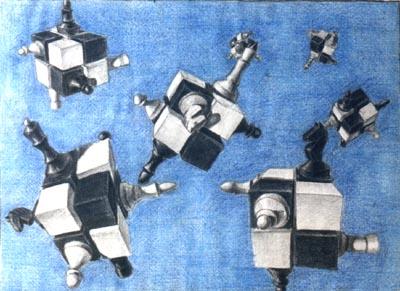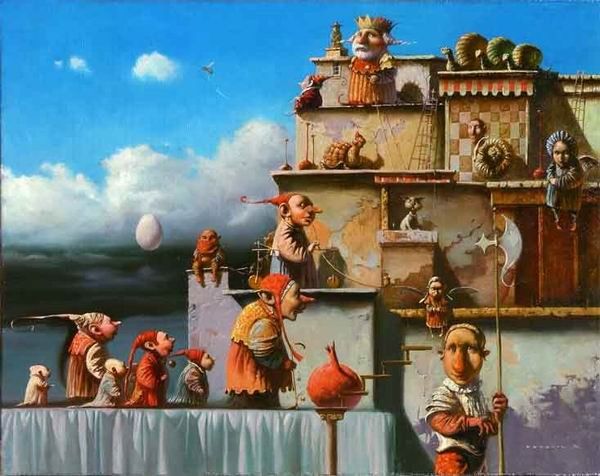
Why Chess Teachers Should Convert to Relationists
LACK OF RELATIONS: WHERE THE EARLY TEACHING IS FAILING THE BEGINNER
It is an undeniable fact that an overwhelming majority of chess learners never advance beyond the moves. Nimzovich hinted us, back in 1929, that there was something "fundamentally false" in the way we started teaching and learning. This blog is my attempt to shed a little light on the possible causes of common, widespread chess blindness and an early loss of motivation and interest for the game.
* * *
It was fascinating to see in the previous post how the same principles of building a network of simple relationships apply to both domains, soccer and chess. In fact, any complex system in existence (ecosystems, organisms, society, the human brain, the living cell, a game of chess, a football match, the entire universe) is created and can only be understood by the relations between its objects, elements, or members. Position, value and other properties of things are only meaningful relative to other things. Space doesn't even exists without interrelated objects. Time doesn't exist either without events when things act upon other things re-forming their configuration in Space. In chess, these events are the moves that represent change in, or transformation of structural relations between pieces. The art of chess really consists in knowing how to beneficially improve this structure, or position of pieces (position, def: a particular way in which something is placed or arranged, Oxford Dictionary).
We know from before that every system is an integration of structure and function. Form is function, and function is form. They are One, joined in a union (Frank Lloyd Wright, btw, the great architect was a son-in-law of Montenegro). Every system is an architectural whole (and we can add another, aesthetic element, or beauty).
Some two thousand years ago, Vitruvius, the Roman author, architect, and military engineer declared that architecture is a package-deal combining firmness, commodity and delight. He also talked structure, function and beauty!
It is becoming obvious that in order to understand how a system, organism, or society works we need to learn the art of interconnectedness and collaboration between system members. One individual doesn't bring meaning to the game. A relationship of two is beginning of the process of building a structure. It is a basic building block of accumulating intelligence as members gather to work together.
At this point I can't but cite a brilliant description by Lewis Thomas in the On societies as organisms chapter from his fascinating The lives of a cell book. On this blog we discuss chess. Yet, we talked of teachings of a soccer coach last time, today we mentioned a Roman architect, now let's hear what a physician, poet, essayist and educator has to say about interrelationships,
"The bees and termites and social wasps , seem to live two kinds of lives: they are individuals, going about the day's business without much evidence of thought for tomorrow, and they are at the same time component parts, cellular elements in the huge, ruminating organism of the Hill, the nest, the hive... a solitary ant, afield, cannot be considered to have much of anything on his mind; indeed, with only a few neurons strung together by fibers, he can't be imagined to have a mind at all, much less a thought. He is more like a ganglion on legs. Four ants together, or ten, encircling a dead moth on a path, begin to look more like an idea. They fumble and shove, gradually moving the food toward the Hill. It's only when you watch the dense mass of thousands of ants, crowded together around the Hill, blackening the ground, that you begin to see the whole beast, and now you observe it thinking, planning, calculating. It is an intelligence, a kind of live computer, with crawling bits for its wits."
And an excerpt from Dee Brown's gripping Bury my heart at wounded knee, an Indian history of American West (p. 117) that tells us once again that it is always about the formation, arrangement of troops and working together,
"[Hook Nose, the Northern Cheyenne leader] called to the warriors not to fight singly as they had always done but to fight together as the soldiers did. He told them to form a line on the open ground between the river and the bluffs. The warrior maneuvered their ponies into a line front facing the soldiers, who were formed on foot before their wagons."
* * *
Now let us illustrate how the relations express themselves in a few more fields.
Math
Math, undeservedly a bête noir for too many people, is also all about structure and relationships. Like in chess, or everywhere else, the real problem lies, again, in the early "teaching." In math, it focuses on calculation instead on general concepts and ideas which should be the case across domains. The basic of everything is mindset, that is the way of thinking. In math, it pretty much should go along these lines: first, we identify a problem from the real world to solve. Then we set up the problem. Here is the simplest setup we can come up, a + b. Finally, it is calculation and testing the solution.
How many object were there in the simplest 'a + b' structure? Two. What was the operation to perform upon? Addition.
Language
Grammar is a system and structure of language. It studies syntax and morphology (an examination of structure and form of words and phrases), and semantics. Syntax describes the rules by which the words and phrases can be combined into sentences, while semantics explains what they mean.
Ok, here is the basic grammatical structure, S-V(-O). Subject, verb, object. How many grammatical objects are there here? Two, the subject and object. What is the operation upon them? Whatever action the verb describes.
There is no meaning without structure.
Coding
In the old days of programming we just coded. In the meantime, a more effective and efficient ways have been invented, notably Object-oriented programming. It is based on the concept of objects having properties and data, and the methods, or functions, by which the objects can access, act upon and modify the data of other objects. Computer programs are thus designed by making them out of objects that interact with each other.
Soccer
In the previous article we discussed soccer. In 'Player A passes the ball to player C' we saw a basic soccer relationship. How many players involved? Two. What is the action? Passing the ball.
From this elementary relation emerges all the complexity during a soccer game. Think what all qualities every individual player has (speed, stamina, vision, etc.) and how many possible relations can be developed between players, ball and the goal posts (kicking, dribbling, heading, etc.). Below check a soccer player's personal card with all his physical and mental attributes and technical skills that my friend @85_PorsheTurbo from Poland used in a comment in the last post:

Chess
Back to chess. We have just seen there is no meaning and understanding without relations and structure. My esteemed chess teachers, it should be perfectly obvious up to now what important ingredient is lacking in the beginner's early stages of learning, don't you think?
Chessmen have only three attributes, exerting the power and body effects and movement. And they carry out only two operations when acting upon enemy pieces, attack and capture (we saw before that all other piece relations as per GM Yuri Averbakh, like restriction, protection and interposition can be deduced from the generic attacking contact).
Now go count (from Mbappe's card above) how many attributes a chess player has and how many relations can be developed in soccer.
Compare that with chess where there are only three chessmen's properties and only two kind of action between them.
Chess, a simple game![]() (just kidding)
(just kidding)
Conclusion
Any theory aspiring to interpret the existence, nature and meaning of things can't do without Relations.
My esteemed chess teachers and coaches, it is about time we all become relationists regarding how we start out teaching, in order to help the beginner form a proper frame of mind that can make further progress beyond the moves possible for many more entrants.
TRADITIONAL WAY: a) we have been introducing (only) one property (movement) which practice is very conducive to aimless wood pushing. b) the other two properties (the power and body effects) explaining the central chess concept of power, in other words the activity of pieces, as well as the relations, have been entirely out of picture.
MODERN WAY: In order to bring understanding and meaning we should start teaching with b) as Nimzovich hinted us back in 1929...
.
Further reading:
1. Learning chess without the moves shown first
2. What chess educators have been failing to see for 90 years now
3. The relations-based Belgrade teaching method
4. Learning chess with relationships, Lesson 1
6. Lesson 2
7. The Belgrade method for complete beginners trial (a guest post by the British coach Jim Stevenson)
.
Tags: basic education, early education, chess education, chess teaching, chess learning
